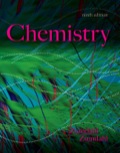
Concept explainers
You are given a small bar of an unknown metal X. You find the density of the metal to be 10.5 g/cm3. An X-ray diffraction experiment measures the edge of the face-centered cubic unit cell as 4.09 Å (1 Å = 10−10 m). Identify X.
Interpretation:
A metal has to be identified given its density and edge length of FCC unit cell.
Concept introduction:
In crystalline solids, the components are packed in regular pattern and neatly stacked. The components are imagined as spheres and closely packed. This phenomenon is called “close packing” in crystals. The two major types of close packing of the spheres in the crystal are – hexagonal close packing and cubic close packing. Cubic close packing structure has face-centered cubic (FCC) unit cell.
In face-centered cubic unit cell, each of the six corners is occupied by every single atom. Each face of the cube is occupied by one atom.
Each atom in the corner is shared by eight unit cells and each atom in the face is shared by two unit cells. Thus the number of atoms per unit cell in FCC unit cell is,
Answer to Problem 55E
Answer
The metal is identified as “Silver”.
Explanation of Solution
Explanation
Calculate the volume of unit cell of unknown metal.
Density of the titanium is given and mass of the titanium is calculated in the previous step. Substituting these two values in the equation
Calculate the mass of unit cell of unknown metal.
Density of the unit cell is given. The mass of unit cell is calculated using the equation
Calculate the atomic mass of unknown metal.
In FCC unit cell of a metal, each unit cell has 4 metal atoms. So each metal atom has an average mass of 1/4th of the mass of unit cell. The atomic mass of a metal atom corresponds to the Avogadro number of the average mass of a metal atom.
Identify the metal corresponding to the atomic mass calculated.
The identified metal is “Silver”.
Platinum is the metal that possibly matches best with the calculated atomic mass.
Conclusion
Density and edge length of FCC unit cell of a metal is given and it is identified as “Silver”.
Want to see more full solutions like this?
Chapter 10 Solutions
EBK CHEMISTRY
- How many hydrogen atoms are connected to the indicated carbon atom?arrow_forwardIdentify the compound with the longest carbon - nitrogen bond. O CH3CH2CH=NH O CH3CH2NH2 CH3CH2C=N CH3CH=NCH 3 The length of all the carbon-nitrogen bonds are the samearrow_forwardIdentify any polar covalent bonds in epichlorohydrin with S+ and 8- symbols in the appropriate locations. Choose the correct answer below. Η H's+ 6Η Η Η Η Η Ηδ Η Ο Ο HH +Η Η +Η Η Η -8+ CIarrow_forward
- H H:O::::H H H HH H::O:D:D:H HH HH H:O:D:D:H .. HH H:O:D:D:H H H Select the correct Lewis dot structure for the following compound: CH3CH2OHarrow_forwardRank the following compounds in order of decreasing boiling point. ннннн -С-С-Н . н-с- ННННН H ΗΤΗ НННН TTTĪ н-с-с-с-с-о-н НННН НН C' Н н-с-с-с-с-н НН || Ш НННН H-C-C-C-C-N-H ННННН IVarrow_forwardRank the following compounds in order of decreasing dipole moment. |>||>||| ||>|||>| |>|||>|| |||>||>| O ||>>||| H F H F H c=c || H c=c F F IIIarrow_forward
- choose the description that best describes the geometry for the following charged species ch3-arrow_forwardWhy isn't the ketone in this compound converted to an acetal or hemiacetal by the alcohol and acid?arrow_forwardWhat is the approximate bond angle around the nitrogen atom? HNH H Harrow_forward
- OH 1. NaOCH2CH3 Q 2. CH3CH2Br (1 equiv) H3O+ Select to Draw 1. NaOCH2 CH3 2. CH3Br (1 equiv) heat Select to Edit Select to Drawarrow_forwardComplete and balance the following half-reaction in acidic solution. Be sure to include the proper phases for all species within the reaction. S₂O₃²⁻(aq) → S₄O₆²⁻(aq)arrow_forwardQ Select to Edit NH3 (CH3)2CHCI (1 equiv) AICI 3 Select to Draw cat. H2SO4 SO3 (1 equiv) HO SOCl2 pyridine Select to Edit >arrow_forward
 Chemistry: Principles and PracticeChemistryISBN:9780534420123Author:Daniel L. Reger, Scott R. Goode, David W. Ball, Edward MercerPublisher:Cengage Learning
Chemistry: Principles and PracticeChemistryISBN:9780534420123Author:Daniel L. Reger, Scott R. Goode, David W. Ball, Edward MercerPublisher:Cengage Learning Principles of Modern ChemistryChemistryISBN:9781305079113Author:David W. Oxtoby, H. Pat Gillis, Laurie J. ButlerPublisher:Cengage Learning
Principles of Modern ChemistryChemistryISBN:9781305079113Author:David W. Oxtoby, H. Pat Gillis, Laurie J. ButlerPublisher:Cengage Learning ChemistryChemistryISBN:9781305957404Author:Steven S. Zumdahl, Susan A. Zumdahl, Donald J. DeCostePublisher:Cengage Learning
ChemistryChemistryISBN:9781305957404Author:Steven S. Zumdahl, Susan A. Zumdahl, Donald J. DeCostePublisher:Cengage Learning Chemistry: The Molecular ScienceChemistryISBN:9781285199047Author:John W. Moore, Conrad L. StanitskiPublisher:Cengage Learning
Chemistry: The Molecular ScienceChemistryISBN:9781285199047Author:John W. Moore, Conrad L. StanitskiPublisher:Cengage Learning Chemistry & Chemical ReactivityChemistryISBN:9781337399074Author:John C. Kotz, Paul M. Treichel, John Townsend, David TreichelPublisher:Cengage Learning
Chemistry & Chemical ReactivityChemistryISBN:9781337399074Author:John C. Kotz, Paul M. Treichel, John Townsend, David TreichelPublisher:Cengage Learning Chemistry by OpenStax (2015-05-04)ChemistryISBN:9781938168390Author:Klaus Theopold, Richard H Langley, Paul Flowers, William R. Robinson, Mark BlaserPublisher:OpenStax
Chemistry by OpenStax (2015-05-04)ChemistryISBN:9781938168390Author:Klaus Theopold, Richard H Langley, Paul Flowers, William R. Robinson, Mark BlaserPublisher:OpenStax





